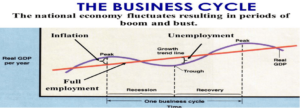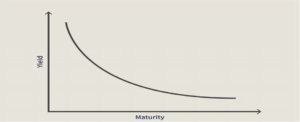Recession is defined as a significant decline in economic activity spread across the economy, lasting more than a few months. It is normally visible in declining real GDP, real income, employment, industrial production, and wholesale-retail sales.
The Reserve Bank of India defines a recession as a period of prolonged decline in output experienced across much of the economy.
More specifically, recession is said to be in progress when total output (real GDP) falls for at least two consecutive quarters.
Contents
Recession: Types
There are several factors that can cause a recession, and recessions can be classified into four basic types based on their causes and recoveries:
Boom and bust recession:
- Most economies experience fluctuations as their overall growth rate rises.
- When an economy “booms,” or exceeds its expected long-term growth rate, it frequently experiences inflation, and then a central bank implements contractionary fiscal policies to control inflation.
- Typically, these policies include raising interest rates, reducing government spending, or raising taxes. This can reduce overall spending and shift consumer priorities to savings and debt repayment, resulting in a recession or “bust.”
Figure 1: Boom and Bust recession (Courtesy: Australian economics, freedom, and peace)
A balance-sheet recession:
- A balance-sheet recession occurs when an economy is overburdened with debt.
- In normal times, the money that wealthy consumers and businesses save with financial institutions is loaned out to other people and businesses, making the economy work efficiently.
- A balance sheet recession occurs when business and consumer spending habits shift because of concern about high debt, and everyone begins to slow spending at the same time to prioritise debt repayment.
Depression:
- A depression is particularly severe and long-lasting type of recession.
- In economics, a depression is a significant downturn in the business cycle characterised by sharp and sustained declines in economic activity, high rates of unemployment, poverty, and homelessness.
- It further results in increased rates of personal and business bankruptcy, massive declines in stock markets, and significant reductions in international trade and capital movements.
Supply side shocks:
- Global events such as wars, natural disasters, or public health crises can cause a significant disruption in domestic or international supply chains, causing an economy to decline.
- These types of recessions may not last long if supply is quickly restored. If not, the effects of the supply shock can be felt for years, as with the ongoing supply issues caused by the COVID-19 pandemic.
Recessionary Gap: It refers to a situation in which an economy is producing below its full capacity, which can result in high levels of unemployment and resource underutilisation.It occurs when the economy’s aggregate demand is insufficient to support full employment and production levels.This can be caused by several factors, including decline in consumer spending, investment, or a drop in government spending.
Concept of Yield Curve: The yield curve depicts the interest rates on bonds with increasing maturities.
Yield curves are of three types:
- Because short-term interest rates are typically lower than long-term interest rates, the yield curve slopes upward, indicating higher yields for longer-term investments. This is known as a normal yield curve.
- The yield curve begins to flatten as the gap between short-term and long-term interest rates narrows.
- A flat yield curve is frequently observed during the transition from a normal to an inverted yield curve.
- The yield curve said to be inverted when short-term interest rates exceed long-term interest rates. An inverted yield curve has been an indicator of upcoming economic recession.
Figure 2: Inverted yield curve (Courtesy: Investopedia)
Recession: Causes
An unexpected economic shock:
- An economic shock is a problem that occurs unexpectedly and causes significant financial damage.
- For example: OPEC unexpectedly doubled oil prices in India in the 1970s, causing an economic crisis.
- A more recent example of a sudden economic shock is the coronavirus outbreak, which shut down economies worldwide.
Uncontrolled Inflation:
- Inflation is defined as a consistent upward trend in prices over time.
- Inflation is controlled by central banks raising interest rates, and higher interest rates slows down the economic activity further causing recession.
Excessive deflation:
- Deflation occurs when prices fall over time, causing wages to contract, further depressing prices.
- When a deflationary feedback loop becomes too strong, people and businesses stop spending, undermining the economy.
Lack of consumer confidence in economy:
- When a Consumers loses confidence in the economy and stop buying, it may create a vicious cycle.
- If demand for goods and services falls sufficiently, business profits and the need or financial capacity to hire more employees will fall.
- As a result, the economy will add fewer jobs, sales will continue to slow, and manufacturers will reduce production in general in response to falling demand.
- Cutting back on production also means cutting back on jobs, which leads to an increase in the unemployment rate, which causes people to cut back on their spending.
Technical Recession in India: A technical recession occurs when an economy has two consecutive quarters of negative economy growth as measured by Gross Domestic Product.Due to Covid-19 pandemic, India experienced a technical recession in 2020.
Recession: Impact in Indian context.
Unemployment:
- Recession cause rise in unemployment especially among low skilled labours as due to less production and income, companies lay off staff to cut down their expenditure.
- Further due to unemployment, expenditure and purchasing power of the people also decreases.
Drop out and shutting down of business:
- The drop in output usually lasts until the weaker companies are forced out of the market, after which output increases among the surviving enterprises.
Drop in government revenue:
- With more people out of work and families struggling to make ends meet, there will be a greater demand for government-funded social programmes.
- When government revenues fall during a recession, it becomes harder to meet the increased demands on the social sector.
Weakening of currencies:
- The depreciation of the Indian currency has an impact on our food, education, healthcare, and other expenses.
- In general, a weaker currency makes imports more expensive while stimulating exports by making them more affordable to overseas customers.
- Over time, a weak or strong currency can contribute to a country’s trade deficit or surplus.
Global supply chain disruptions:
- The supply side shocks such as Ukraine -Russia war disrupted the global supply chain, driving up the prices of crude oil and other commodities.
- Increased fuel prices raise transportation costs, putting an additional burden on daily food commodities as well as essential non-edible products.
Decrease in Investment:
- Due to several instabilities and decreased demand, investors try to hold on the money which further impact the circulation of money in the economy.
Recession: Types of recoveries
Economists use recovery shapes to describe various types of recessions and their subsequent recoveries. The shapes are represented by letters such as V, U, W, L, and K, and are named after how each recovery appears when plotted on a graph that measures the overall condition of the economy.
- A V-shaped recession recovery is characterized by a sharp decline in economic activity followed by a quick and strong recovery. In this type of recession, the decline in economic activity is usually caused by a temporary shock to the economy.
- A U-shaped recession recovery is characterized by a more prolonged period of decline and stagnation before a gradual recovery takes place. In this type of recession, economic activity takes longer to recover than in a V-shaped recession, and the trough of the GDP curve is generally more extended.
- A W-shaped recession recovery, also known as a double-dip recession recovery, is characterized by a temporary recovery in economic activity followed by a second period of decline and recession. The second dip can have a greater impact on consumer confidence because it creates uncertainty about the future direction of the economy, causing consumers to hesitate before resuming spending and investment.
- A L-shaped recession recoveryhave long-term effects on growth, permanently slowing GDP growth and frequently approaching depression levels. The economy recovery is slow, unemployment is high, and investment is low.
- A K-shaped recession recovery refer to a situation where different sectors or groups of the economy experience vastly different outcomes during a recession and recovery. some sectors or groups of the economy may experience a rapid recovery and growth, while others may continue to decline or stagnate.
However, the strength of the Indian economy can contribute to the country’s favourable economic growth. As a result, India would not be as severely affected by the global recession as other countries. According to the Indian Economic Survey 2022-23, despite the uncertainty in western economies, India is expected to have a real growth rate of 6-6.8% in fiscal year 2022-23.
Secondly, as India’s foreign exports account for only one-fifth of the country’s total GDP, the impact of an economic slowdown in Western countries is less severe. The diversified nature of India’s exports, both geographically and in terms of the products/services it sells, further protects the Indian economy, making it less vulnerable to concentrated economic shocks.






